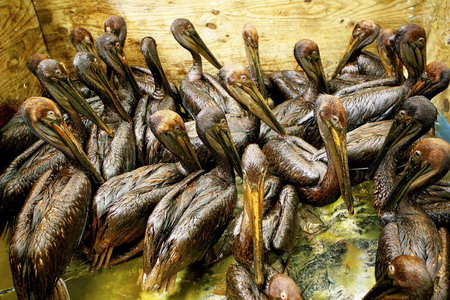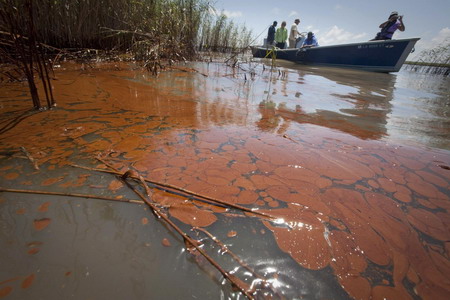Asia-Pacific
BP spill nears a somber record as Gulf's biggest
(Agencies)
Updated: 2010-07-01 22:05
 |
Large Medium Small |
|
|
Along the US Gulf Coast, Hurricane Alex was whipping oil-filled waves onto the area's once-white beaches. The government has pinned its latest cleanup hopes on a huge new piece of equipment: the world's largest oil-skimming vessel, which arrived Wednesday.
Officials hope the ship can scoop up to 21 million gallons (80 million liters) of oil-fouled water a day. Dubbed the "A Whale," the former tanker spans the length of 3 1/2 football fields and is 10 stories high.
It just emerged from an extensive retrofitting to prepare it specifically for the Gulf.
The vessel looks like a typical tanker, but it takes in contaminated water through 12 vents on either side of the bow. The oil is then supposed to be separated from the water and transferred to another vessel. The water is channeled back into the sea.
But the ship's never been tested, and many questions remain about how it will operate. For instance, the seawater retains trace amounts of oil, even after getting filtered, so the Environmental Protection Agency will have to sign off on allowing the treated water back into the Gulf.
"This is a no-brainer," Overton said. "You're bringing in really dirty, oily water and you're putting back much cleaner water."
The Coast Guard will have the final say in whether the vessel can operate in the Gulf. The owner, shipping firm TMT Group, will have to come to separate terms with BP, which is paying for the cleanup.
"I don't know whether it's going to work or not, but it certainly needs to be given the opportunity," Overton said.
|
|
Meanwhile along parts of the Gulf, red flags snapped in strong gusts, warning people to stay out of the water, and long stretches of beach were stained brown from tar balls and crude oil that had been pushed as far as 60 meters from the water.
Hurricane Alex churned up rough seas as it plowed across the Gulf, dealing a tough setback to cleanup operations. It made landfall along a relatively unpopulated stretch of coast in Mexico's northern Tamaulipas state late Wednesday, spawning tornadoes in nearby Texas and forcing evacuations in both countries. Alex weakened to a tropical storm Thursday morning as it moved across Mexico.
Although skimming operations and the laying of oil-corralling booms were halted across the Gulf, vessels that collect and burn oil and gas at the site of the explosion were still operating. Efforts to drill relief wells that experts hope will stop the leak also continued unabated.
In Florida, lumps of tar the size of dinner plates filled a large swath of beach east of Pensacola after rough waves tossed the mess onto shore. Streaks of the rust-red oil could be seen in the waves off Pensacola Beach. In Grand Isle, Louisiana, heavy bands of rain pounded down, keeping cleanup crews off the water and tossing carefully laid boom around. However, oil had stayed out of the passes.
"All this wave action is breaking up the oil very quickly," Coast Guard Cmdr. Randal S. Ogrydziak said. "Mother Nature is doing what she does best, putting things back in order."
Natural microbes in the water were also working on the spill. The result was a white substance that looked like mayonnaise, that washed up on some spots along the Grand Isle beach.
"People will be fishing here again," Ogrydziak said. "It may take a while, but people may be surprised that it's not taking as long as they thought. Look at the (Ixtoc) oil spill in Mexico. It was massive and now people are back to using those waters."





